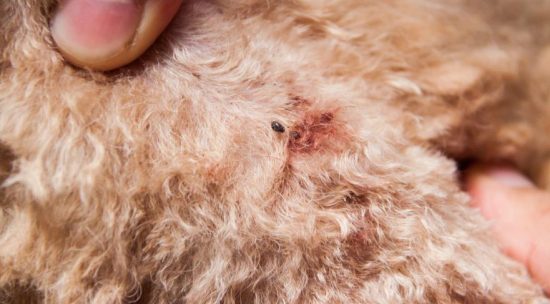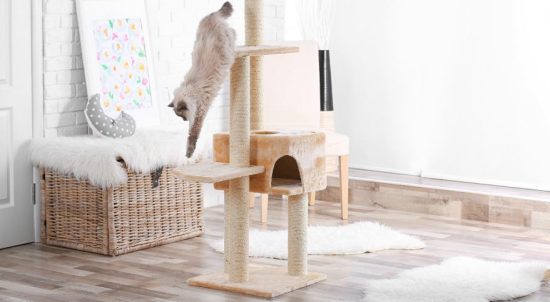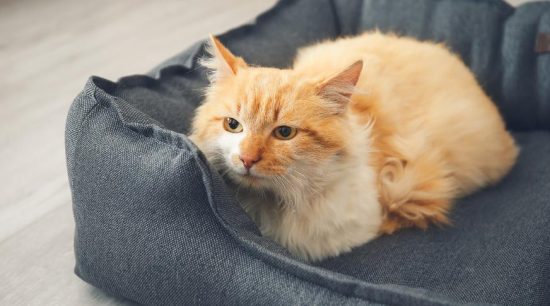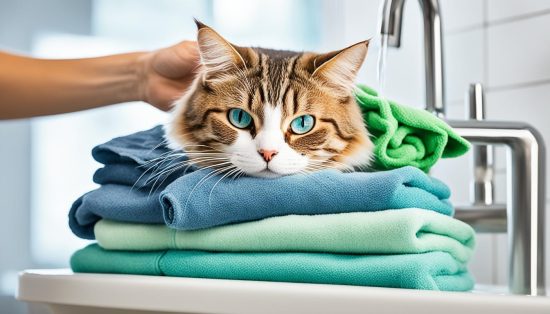If My Cat Has Fleas Do I Need to Treat My House?
Discover if treating your house is necessary when your cat has fleasespecially if your feline friend is dealing with a flea problem.

Did you know that fleas can lay up to 50 eggs per day on your cat’s fur? While fleas primarily live on the host, they can also infest your home and turn into a full-blown flea infestation. The eggs laid on your cat’s fur can fall into your home environment, landing on carpets, bedding, and other areas your cat loves to spend time in. These eggs hatch, mature, and then jump back onto your cat, completing the flea life cycle.
If you only treat your cat without addressing your home, you risk a recurring flea problem. To eliminate fleas effectively, treating both your cat and your house is necessary. This blog will provide you with insights into the flea lifecycle and the risks of infestation in your home. We will also discuss strategies for treating your home and preventing future flea outbreaks.
Understanding the Flea Lifecycle and Infestation Risks in Your Home

When it comes to tackling a flea infestation in your home, it is essential to understand the flea lifecycle and the potential risks they pose. By gaining insight into how fleas spread from pets to home environments and the specific conditions that allow them to thrive indoors, you can develop an effective strategy to eliminate these pesky pests.
Fleas have a remarkable ability to move from your pets to your home. When your cat has fleas, adult fleas lay eggs on their fur. These tiny eggs then fall off your pet and onto various surfaces in your home. From there, they hatch into larvae, which feed on organic matter found in carpets, bedding, and furniture. After the larvae spin cocoons and develop into pupae, adult fleas emerge and search for a host, often jumping back onto your pet. This continuous cycle makes it crucial to treat both your cat and your home simultaneously to prevent re-infestations.
The Conditions that Allow Fleas to Thrive Indoors
Fleas thrive in specific conditions that can be found in many homes. Warm temperatures, between 70°F and 85°F, provide an ideal environment for fleas to flourish. High humidity levels also contribute to their survival and reproduction. These conditions can be especially favorable during the summer months or in regions with a moderate climate. Dark and undisturbed areas, such as carpets, bedding, and furniture, create perfect hiding spots for fleas to lay their eggs and complete their lifecycle. Taking steps to maintain a clean and well-ventilated home can help reduce the risk of flea infestations.
| Flea Lifecycle Stage | Duration | Optimal Conditions |
|---|---|---|
| Egg | 2-14 days | Warm temperature, high humidity |
| Larva | 5-11 days | Dark and undisturbed areas, organic matter for food |
| Pupa | 7-14 days | Protected location, moderate temperature |
| Adult | Several weeks to several months | Warm temperature, access to a host |
If My Cat Has Fleas Do I Need to Treat My House?

If your cat has fleas, it is highly recommended to treat your house as well. While the primary focus should be on treating your cat, ignoring the house can lead to re-infestations. Treating both your cat and your house simultaneously is the most effective way to eliminate fleas and prevent future outbreaks.
Treating the house involves comprehensive cleaning, vacuuming, and using appropriate flea treatment products. By thoroughly cleaning your house, you can remove any flea eggs, larvae, or pupae that may be hiding in carpets, furniture, or other surfaces. Vacuuming is a crucial step in this process as it helps to physically remove fleas and their eggs from your home. Additionally, using flea treatment products will help to kill any remaining fleas and prevent new infestations.
Remember, fleas can reproduce rapidly and infest your home, so treating your house is an important part of eliminating fleas and ensuring their long-term control. By taking these steps, you can create a flea-free environment for both your cat and your entire household.
| Treatment Steps for Your House | Notes |
|---|---|
| Comprehensive Cleaning | Vacuum carpets, furniture, and other surfaces to remove flea eggs, larvae, and pupae |
| Use appropriate flea treatment products | Choose products that are recommended for use in the home and follow the instructions carefully |
| Wash bedding and fabrics | Hot water and detergent can help kill fleas and remove their eggs |
| Apply flea spray or insecticide | Treat areas where fleas may be hiding, such as cracks and crevices |
Initial Steps to Take When You Discover Fleas on Your Cat
When you discover fleas on your cat, it is important to take immediate action to prevent the infestation from spreading. Fleas can quickly multiply and infest not only your cat but also your home, so timely treatment is essential.
Identifying the Presence of Fleas on Your Feline Friend
The first step is to identify the presence of fleas on your cat. Look out for the following signs:
- Excessive scratching: If your cat is constantly scratching herself, especially around the neck, behind the ears, or at the base of the tail, it could be a sign of fleas.
- Flea dirt: Flea dirt looks like tiny black specks resembling dirt. You may notice it on your cat’s fur, especially in areas where fleas tend to hide.
- Restlessness: Fleas can make your cat feel uncomfortable and restless. If your cat seems more agitated or fidgety than usual, fleas could be the culprit.
- Excessive grooming: Cats groom themselves regularly, but if you notice your cat grooming excessively or focusing on one particular area, it could be a response to fleas.
If you observe any of these signs, there is a high likelihood that your cat has fleas.
Why Immediate Treatment is Crucial for Control
Immediate treatment is crucial for controlling the flea infestation. Fleas can reproduce rapidly, laying eggs that fall off your cat and into your home environment. These eggs hatch into larvae, pupate, and eventually develop into adult fleas. Without prompt action, the infestation can quickly escalate, making it more challenging to eliminate.
Additionally, fleas can cause various health problems for your cat, including flea allergy dermatitis, anemia, and the transmission of other parasites and diseases.
Isolating the Infestation: How to Handle Your Pet and Living Spaces
When dealing with a flea infestation, it is crucial to take measures to isolate the infestation and prevent further spread. This involves handling both your pet and living spaces to effectively eliminate fleas and minimize the risk of re-infestations.
Isolating Your Pet

One of the first steps is to temporarily confine your pet to certain areas of the house to prevent fleas from spreading to other parts of your home. This can be done by closing off access to rooms or using pet gates to restrict their movement. By limiting their range, you can minimize the chances of fleas infesting additional areas.
In addition to confinement, it is important to use proper flea control measures on your pet. This may include topical treatments, flea collars, or oral medications recommended by your veterinarian. These products can help eliminate fleas from your pet’s fur and prevent new infestations. It is essential to carefully follow the instructions provided by your veterinarian when using flea control products. Each product has specific application instructions and safety guidelines, so make sure to adhere to them to protect your pet’s health and well-being.
Treating Living Spaces
Alongside handling your pet, thorough cleaning and treatment of affected areas in your living spaces are necessary to eliminate fleas and prevent re-infestations. Start by thoroughly vacuuming all carpets, rugs, and furniture, paying extra attention to areas where your pet spends most of their time. This helps remove flea eggs, larvae, and pupae from the environment.
For effective flea control, consider using an appropriate insecticide or flea spray that is safe for use in your home. Be sure to choose products specifically designed for controlling fleas, following the instructions provided on the labels. Treat high-risk areas such as pet bedding, upholstery, and carpeted areas where fleas are likely to hide and reproduce.
In addition to treatment, regular cleaning and maintaining a clean living environment can help prevent flea infestations. Vacuuming frequently, washing pet bedding regularly, and keeping your home clutter-free can reduce the chances of fleas finding suitable breeding grounds.
By implementing these measures and properly isolating the flea infestation, you can effectively handle your pet and living spaces to eliminate fleas and prevent future outbreaks.
Preventative Measures to Protect Your Cat and Home from Future Flea Outbreaks
To ensure the well-being of your cat and maintain a clean home, it is crucial to take preventative measures to protect against future flea outbreaks. Regular grooming and flea control treatments for your cat are essential in preventing fleas. Consult with your veterinarian for recommendations on topical medications or flea collars that are effective in controlling fleas. These preventive measures can significantly reduce the risk of your cat becoming infested with fleas.
In addition to cat-focused measures, it is important to regularly vacuum and clean your carpets, furniture, and bedding. Fleas and their eggs can hide in these areas, so maintaining cleanliness is key. Vacuuming eliminates fleas at all life stages, including eggs, larvae, and adults. By diligently cleaning and treating these areas, you can prevent fleas from infesting your home.
Don’t forget to consider your outdoor spaces as well. Treating your yard and other outdoor areas where your cat spends time can help reduce the chances of fleas hitching a ride into your home. Consult with a pest control professional or your veterinarian for recommendations on proper outdoor flea treatments. By addressing all potential areas of infestation, you can minimize the risk of future flea outbreaks and protect the well-being of your cat.
FAQs on If my cat has fleas do I need to treat my house
Do I need to wash my bedding if my cat has fleas?
Yes, washing your bedding is recommended if your cat has fleas. Flea eggs can fall onto the bedding, and washing it can help remove any eggs or fleas present.
Is it okay to sleep with my cat if she has fleas?
It is not recommended to sleep with your cat if she has fleas. This increases the chances of fleas spreading to your bedding, furniture, and other areas of your home.
Should I isolate my cat if it has fleas?
Yes, isolating your cat is a good step to prevent the further spread of fleas. This may involve temporarily confining your cat to certain areas of the house or using flea control measures such as topical treatments or flea collars.
Can I still touch my cat if it has fleas?
Yes, you can still touch your cat if it has fleas. However, it is important to take immediate action to treat the fleas and prevent their spread to yourself, other pets, or your home.
Is it okay to cuddle my cat with fleas?
It is generally not recommended to cuddle your cat if it has fleas. Fleas can jump onto you or your clothing, increasing the risk of bringing them into your home or spreading them to other areas.







